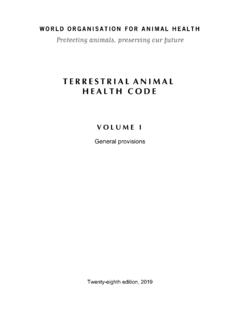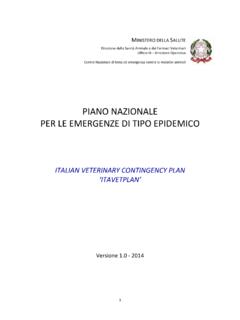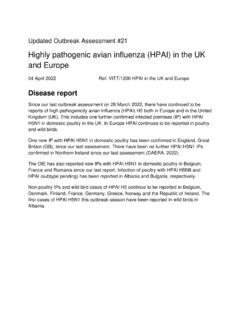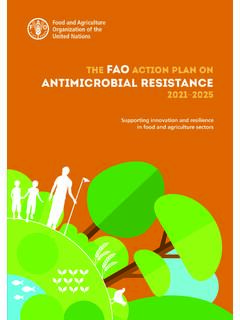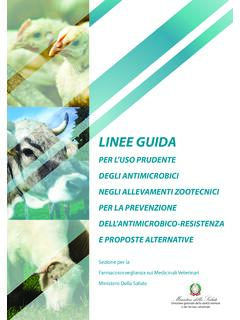Transcription of Classification of the causative agent Resistance to physical …
1 AFRICAN SWINE FEVER Aetiology Epidemiology Diagnosis Prevention and Control References AETIOLOGY Classification of the causative agent African swine fever virus (ASFV) is a DNA virus in the Asfarviridae Family; genus Asfivirus. ASFV is the sole member of its genus but viral genotypes have been identified by restriction enzyme and sequence analysis. Virulence of ASFV isolates vary greatly and standard nomenclature of isolates includes City or Country of isolation and last two digits of year of isolation ( Lisbon 60, DR 78). It is the only known DNA arbovirus.
2 Resistance to physical and chemical action Temperature: Highly resistant to low temperatures. Heat inactivated by 56 C/70 minutes; 60 C/20 minutes. pH: Inactivated by pH < or > in serum-free medium. Serum increases the Resistance of the virus, at pH Resistance lasts up to 21 hours without serum, and 7 days with serum. Chemicals/Disinfectants: Susceptible to ether and chloroform. Inactivated by 8/1000 sodium hydroxide (30 minutes), hypochlorites chlorine (30 minutes), 3/1000 formalin (30 minutes), 3% ortho-phenylphenol (30 minutes) and iodine compounds.
3 Survival: Remains viable for long periods in blood, faeces and tissues; especially infected, uncooked or undercooked pork products. Can multiply in vectors (Ornithodoros sp.). EPIDEMIOLOGY ASF epidemiology is complex with different epidemiological patterns of infection occurring in Africa and Europe. ASF occurs through transmission cycles involving domestic pigs, wild boars, wild African suids, and soft ticks Hosts African wild swine (warthogs (Phacochoerus aethiopicus), bush pigs (Potamochoerus sp.), giant forest hogs (Hylochoerus meinertzhageni) are usually inapparently infected and act as reservoir hosts of ASFV in Africa o Hosts that demonstrate disease: domestic pigs (Sus domestica), European wild boar, and American wild pigs Ticks of the genus Ornithodoros are considered the natural arthropod host and there exists some speculation that ASFV is a virus of arthropods and that mammalian species, such as domestic swine, represent accidental hosts Transmission Direct transmission.)
4 O contact between sick and healthy animals Indirect transmission: o feeding on garbage containing infected meat (ASFV can remain infectious for 3 6 months in uncooked pork products) o biological vectors soft ticks of the genus Ornithodoros o fomites include, premises, vehicles, implements, clothes Within tick vector: transstadial, transovarial, and sexual transmission occur Sources of virus Blood, tissues, secretions and excretions of sick and dead animals Animals which have recovered from either acute or chronic infections may become persistently infected, acting as virus carriers; especially in African wild swine, and in domestic pigs in enzootic areas Soft ticks of the genus Ornithodoros Occurrence African swine fever is enzootic in most countries of Sub-Saharan Africa including Madagascar.
5 In Europe, it has been reported and successfully eradicated from the Iberian Peninsula but continues to be found in Sardinia. In the 1970s, ASFV was present in the Caribbean (Haiti and the Dominican Republic) and one country in South America (Brazil) but was successfully eradicated. Most recently, it has appeared in the Caucasus (Georgia, Azerbaijan, and Armenia) and Russia. For more recent, detailed information on the occurrence of this disease worldwide, see the oie World animal health Information Database (WAHID) interface [ ] or refer to the latest issues of the World animal health and the oie Bulletin.
6 DIAGNOSIS Incubation period in nature is usually 4 19 days; acute form 3 4 days. For the purposes of the oie terrestrial animal health code , the incubation period in Sus scrofa is 15 days. Clinical diagnosis Peracute (highly virulent virus) Sudden death with few signs Acute form (highly virulent virus) Fever ( 42 C) Early leucopoenia and thrombocytopenia (48 72 hours) Reddening of the skin (white pigs) tips of ears, tail, distal extremities, ventral aspects of chest and abdomen Anorexia, listlessness, cyanosis and incoordination within 24 48 hours before death Increased pulse and respiratory rate Vomiting, diarrhoea (sometimes bloody)
7 And eye discharges may exist Death within 6 13 days, or up to 20 days Abortion may occur in pregnant sow Survivors are virus carriers for life In domestic swine, the mortality rate often approaches 100% Subacute form (moderately virulent virus) Less intense signs; slight fever, reduced appetite and depression Duration of illness is 5 30 days Abortion in pregnant sows Death within 15 45 days Mortality rate is lower ( 30 70%, varies widely) Chronic form (moderately or low virulent virus) Various signs: loss of weight, irregular peaks of temperature, respiratory signs, necrosis in areas of skin, chronic skin ulcers, arthritis Pericarditis, adhesions of lungs, swellings over joints Develops over 2 15 months Low mortality Lesions Acute form (not all lesions are seen.)
8 This depends on the isolate) Pronounced haemorrhages in the gastrohepatic and renal lymph nodes Petechial haemorrhages of the renal cortex, also in medulla and pelvis of kidneys Congestive splenomegaly Oedematous areas of cyanosis in hairless parts Cutaneous ecchymoses on the legs and abdomen Excess of pleural, pericardial and/or peritoneal fluid Petechiae in the mucous membranes of the larynx and bladder, and on visceral surfaces of organs Oedema in the mesenteric structures of the colon and adjacent to the gall bladder; also wall of gall bladder Chronic form Focal caseous necrosis and mineralisation of the lungs may exist Lymph nodes enlarged Differential diagnosis Classical swine fever (CSF or hog cholera) o not possible to differentiate ASF and CSF by clinical or post-mortem examination.
9 Essential to send samples for laboratory examination Porcine reproductive and respiratory syndrome (PRRS) Erysipelas Salmonellosis Aujeszky s disease (or pseudorabies) [younger swine] Pasteurellosis other septicaemic conditions Laboratory diagnosis Samples Identification of the agent A complete set of field samples should be submitted and especially: o blood collected during the early febrile stage in EDTA ( ) o spleen, lymph nodes, tonsil and kidney kept at 4 C Serological tests Serum collected within 8 21 days after infection in convalescent animals Procedures Identification of the agent Isolation: o cell culture inoculation (primary cultures of pig monocytes or bone marrow cells most isolates produce haemadsorption) a) Haemadsorption test (HAD) positive HAD test result is definitive for ASF diagnosis (two procedures) o procedure 1: in primary leukocyte cultures o procedure 2.
10 Autorosette test with peripheral blood leukocytes from infected pigs b) Antigen detection by fluorescent antibody test (FAT) positive FAT plus clinical signs and appropriate lesions can provide a presumptive diagnosis of ASF c) Detection of virus genome by the polymerase chain reaction PCR techniques are particularly useful when samples may be unsuitable for virus isolation or antigen detection (putrefaction)d) Pig inoculation is no longer recommended for use Serological tests a) Enzyme-linked immunosorbent assay (the prescribed test for international trade) b) Indirect fluorescent antibody (IFA) test should be used as a confirmatory test for sera from areas that are free from ASF and are positive in the ELISA, and for sera from endemic areas that give an inconclusive result in the ELISA c)










